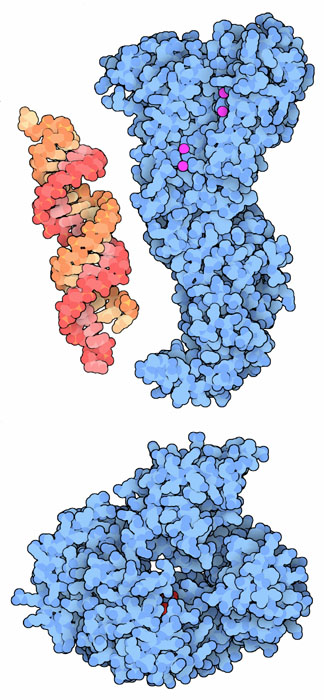|
Inhaltsübersicht | Nanomaschinen | Moleküle | Programme | Kurse | Fun | Links |
||
| > |
Small Interfering RNA (siRNA)

Next:
Double-stranded RNA is often a sign of trouble. Our transfer RNA and ribosomes do contain little hairpins that are double-stranded, but most of the free forms of RNA, messenger RNA molecules in particular, are single strands. Many viruses, however, form long stretches of double-stranded RNA as they replicate their genomes. When our cells find double-stranded RNA, it is often a sign of an infection, and they mount a vigorous response that often leads to death of the entire cell. However, plant and animal cells also have a more targeted defense that attacks the viral RNA directly, termed RNA interference.
Running Interference
RNA interference starts with a long double-stranded RNA, such as the ones formed as viruses replicate. The protein dicer, shown here at the top in blue from PDB entry 2ffl, cuts this RNA into small, distinctive pieces called small interfering RNA (siRNA), shown on the left from PDB entry 2f8s. Each siRNA is about 21 base pairs long and has a distinctive overhang of two base pairs on each strand, and a left-over phosphate at the other end of each strand. This makes them easy to recognize. In the dicer protein, notice how the four manganese ions (in magenta) are arranged. They are thought to make two offset cuts in the RNA double helix, forming the overhang.
The Argonaute
The siRNA molecules made by dicer are picked up by argonaute proteins and used to destroy any other viral RNA that is floating around. The argonaute protein, shown here at the bottom from PDB entry 1u04, strips away one strand from the siRNA, and then looks for any messenger RNA that matches it. If it finds some, it cleaves the RNA, destroying it. In this way, the cell removes any messenger RNA that is the same as the original double-stranded piece found by dicer. (A piece of trivia: the argonaute protein was discovered in a mutant plant that was shaped like the spiral shells of marine argonauts.)
A Sea of Small RNA
In the years since the discovery of RNA interference, researchers have found that this process is far more widespread than we might expect, and that small pieces of RNA play many functional roles. A similar class of molecules, termed microRNA, are created in the nucleus from the normal RNA of the cell. These are also processed by dicer and are used to modulate the use of our normal messenger RNA, by pairing with the RNA and blocking its use. They also find complementary sequences in the DNA genome, modifying the properties of the chromosomes by changing the levels of methylation or histone binding.
Interfering RNA in Science
Plant and animal cells are prepackaged with this machinery for destroying specific RNA strands, and scientists have taken full advantage of it. It is now possible to synthesize a non-natural interfering RNA, then insert it into a cell and destroy any messenger RNA that we desire. This is a fast and easy way to determine the function of a gene: you destroy most of the messenger RNA using a custom interfering RNA, thus slowing production of the protein, and see what goes wrong. Medical researchers are also trying to use these small RNA molecules to fight disease, for instance, using them to knock out cancer genes.
Last changed by: A.Honegger,